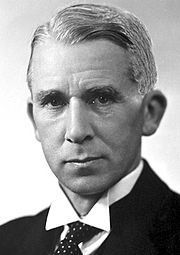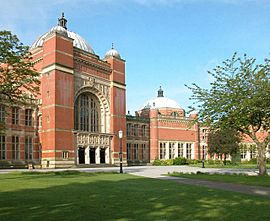Norman Haworth facts for kids
Quick facts for kids
Sir Norman Haworth
|
|
|---|---|

Norman Haworth
|
|
| Born | 19 March 1883 White Coppice, Lancashire, England
|
| Died | 19 March 1950 (aged 67) Barnt Green, Worcestershire, England
|
| Nationality | British |
| Alma mater | University of Manchester University of Göttingen |
| Known for | investigations on carbohydrates and vitamin C |
| Awards | Longstaff Prize (1933) Davy Medal (1934) Nobel Prize for Chemistry (1937) Royal Medal (1942) |
| Scientific career | |
| Fields | Organic chemistry |
| Institutions | University of St. Andrews Durham University University of Birmingham |
| Doctoral advisor | William Henry Perkin, Jr., Otto Wallach |
Sir Walter Norman Haworth (born March 19, 1883 – died March 19, 1950) was a famous British chemist. He is best known for his important work on ascorbic acid (which is vitamin C). He did much of this work while at the University of Birmingham.
In 1937, he won the Nobel Prize in Chemistry. He received the award "for his investigations on carbohydrates and vitamin C." He shared the prize with a Swiss chemist named Paul Karrer, who studied other vitamins.
Haworth also figured out the correct shapes of many sugars. He is known for creating the Haworth projection. This is a special way to draw three-dimensional sugar structures as flat, two-dimensional pictures. It makes them easier for chemists to understand.
Contents
Haworth's Journey in Chemistry
Early Life and Education
When he was 14, Norman Haworth started working in his father's factory. It made linoleum, a type of floor covering. Even though his parents didn't want him to, he decided to study chemistry.
In 1903, he passed the entrance exam for the University of Manchester. He earned his first-class honors degree in 1906. After getting his master's degree, he went to the University of Göttingen in Germany. He earned his PhD there in just one year.
Work at St Andrews and Durham
In 1912, Haworth became a teacher at the University of St Andrews in Scotland. There, he became very interested in carbohydrate chemistry, which is the study of sugars.
During World War I (1914–1918), Haworth helped organize the labs at St Andrews University. They produced important chemicals and medicines for the British government.
In 1920, he became a professor at Durham University. The next year, he became the head of the Chemistry Department there. While in the North East of England, he married Violet Chilton Dobbie.
Discoveries at Birmingham University

In 1925, Haworth moved to the University of Birmingham. He became the Mason Professor of Chemistry and stayed there until 1948. One of his biggest achievements was confirming the structures of many sugars. By 1928, he had figured out the shapes of sugars like maltose, lactose, and cellobiose. He also wrote an important book about sugars in 1929 called The Constitution of Sugars.
In 1933, Haworth worked with a team, including Edmund Hirst and Maurice Stacey. They figured out the correct structure of vitamin C. Haworth then successfully created the vitamin in the lab.
He had received a sample of "hexuronic acid" (the old name for vitamin C) from a Hungarian scientist named Albert Szent-Györgyi. Szent-Györgyi had found that this compound could be taken from Hungarian paprika. Because it helped prevent scurvy (a disease), Haworth and Szent-Györgyi suggested calling it "a-scorbic acid." Its official chemical name is L-ascorbic acid.
During World War II, Haworth was part of the MAUD Committee. This group looked into research for the British atomic bomb project.
How Haworth is Remembered
Haworth Building and Chair
At the University of Birmingham, there is a building named the Haworth Building. It is where most of the School of Chemistry is located. The university also has a special teaching position called the Haworth Chair of Chemistry.
Postage Stamp and Haworth Projection
In 1977, the Royal Mail (Britain's postal service) put Haworth on a postage stamp. This stamp celebrated his achievement in making vitamin C and winning the Nobel Prize.
He also created a simple way to draw the three-dimensional shape of sugars on paper. This drawing method is called a Haworth projection. It is still used a lot today in the study of living things and chemistry.
Personal Life
In 1922, Norman Haworth married Violet Chilton Dobbie. They had two sons, James and David.
He was chosen as a Fellow of the Royal Society (FRS) in 1928. This is a very high honor for scientists in the UK.
He was made a knight in 1947, so he became "Sir" Norman Haworth.
He died suddenly from a heart attack on March 19, 1950. It was his 67th birthday.
See also
 In Spanish: Walter Norman Haworth para niños
In Spanish: Walter Norman Haworth para niños

